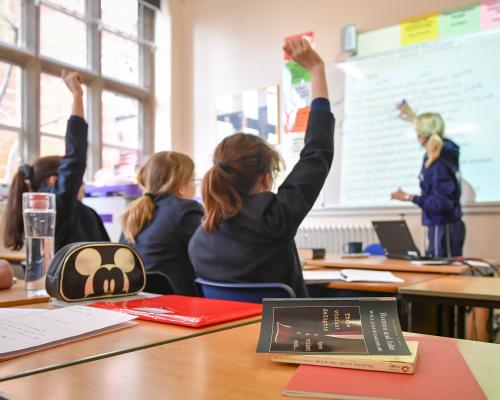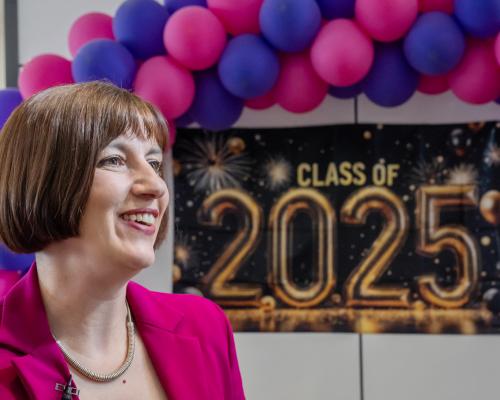
Ministers plan to turbocharge their school improvement programme to tackle regional inequalities, aiming to export the success of London’s high-achieving pupils to England’s most struggling schools.
Bridget Phillipson, the education secretary, said her school improvement plan was “taking the best” of the previous Labour government’s successful London Challenge, which revolutionised the city’s school system, and applying the techniques to flagging schools throughout England.
This week’s A-level results raised alarm at the widening gap between results in London and regions outside the south-east of England, particularly in the Midlands and the north-east, where improvements in top grades have been stagnant.
The Department for Education is to double the number of schools being supported by its regional improvement for standards and excellence (Rise) programme, which identifies “stuck schools” with repeated poor inspection reports, and aim to transform them through expert assistance from experienced school leaders and partnerships, as well as up to £200,000 over two years in extra funding.
Phillipson said: “This week’s exam results were a time for celebration, but they also laid bare the yawning attainment gaps at A-level that continue to cast a shadow over so many areas of the country.
“It’s appalling that young people across the north-east, the East Midlands and West Midlands continue to be held back compared to their peers in London.
“That’s why, as part of our plan for change, we are putting a laser focus on those areas of the country, and those schools where performance is weakest, with our new school improvement teams – taking the best of the renowned London Challenge and applying it to areas like the north-east, to make sure that every single child, wherever they grow up, has the life chances they deserve.”
The rollout of the Rise programme is backed by the former education secretary David Blunkett and Sir Kevan Collins, the government’s school improvement tsar, who were involved in the London Challenge after it was launched in 2003.
Lord Blunkett applauded the early intervention in schools through the Rise teams, saying the policy would “narrow the gap and create a more equal start in life, so crucial to releasing the talent, creativity and self-reliance of young people”.
In London, the government used data to identify schools with the most glaring problems, and then worked with local authorities to overhaul each school’s leadership and culture, while also working with parents and wider communities to tackle specific issues in boroughs such as Tower Hamlets, where Collins was a senior leader. By 2010, London had a higher proportion of schools rated as good or outstanding by Ofsted than any other area of England.
The initial phase of Rise began earlier this year, after 600 schools were identified as urgently needing support. More than 200 were matched with advisers and partners, and must create an approved plan for transformation before receiving up to £200,000 in extra funding spread over two years.
The DfE said a further 200 schools would be added “very quickly” in the autumn, when the new school year commences, as a sign of the government’s recognition of the urgency.
Collins said: “The emphasis [of Rise] is all about pace, because the one thing about schools that start to decline, the slide becomes embedded. They can’t recruit great staff, people start leaving, attitudes become habitual. You need to be radical to turn that around, and the longer you leave it, the harder it is. This is what is so shameful about these schools being left like this for so long.”
He added: “One of the things about the London Challenge was that it was very high-profile and with a sense of endeavour – everyone was leaning into it, it had massive national leadership. There was a big effort, a clear effort, and that is what we are trying to replicate with Rise.”
Jon Coles, the director of the London Challenge when it launched under the leadership of Tim Brighouse, and who is now the chief executive of the United Learning academy trust, said: “The history of the London Challenge shows that you can make a big difference, that these things are not inevitable.
“Twenty years ago, inner London performed less well than every region in the country. And now the only place that outperforms inner London is outer London.
“So things can change. But it requires people to decide they are going to work together, have a great strategy, take tough decisions, collaborate beyond boundaries, in order to make things better for children.”
Thursday’s A-level results showed the gap between the best- and worst-performing regions widened again this year, with 32% of entries in London gaining the top A* or A grades, compared with fewer than 23% in north-east England.
Young people in the north-east of England are also less likely to take A-levels than their peers in London and the south-east. Research published by the DfE in July showed that more than half of children in inner London eligible for free school meals at the age of 15 went on to higher education by the age of 19, compared with 22% in the north-east and the east Midlands.





